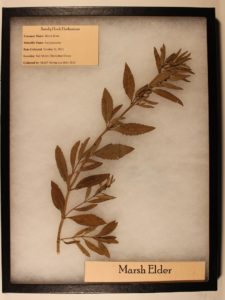| Common Name(s) | Marsh Elder, High-Tide Bush | ||||
| Scientific Name | Iva frutescens | ||||
| Family | Asteraceae | ||||
| Location/Vegetative Zone | Salt Marsh | ||||
| Flowering Period | August-October | ||||
| Identifying Characteristics | Freely branched shrubs | ||||
Description
• The marsh elder is a deciduous shrub that reaches a height of 3 – 8 feet • It has an erect stem that features coarse branching aiming upward.
• The leaves are egg-shaped and feature serrated margins. They are arranged alternately on the stem and grow up to 4 – 6 inches in length and 1 – 2 inches in width. The face of the leaves are gland-dotted and contain small hairs.
• The flowers are yellow or white in color with very small corolla (collective term for petals).
• It features small, dry fruits that are dark purplish brown in color and have pale dots of resin.
Uses
• The seeds contained oils that were used by Native Americans from 7,000 years ago.
• It serves as a barrier for shorelines in preventing erosion.
• It can be used as a border plant or a low hedge.
Misc
• Noted as a threatened species in New Hampshire and as an endangered species in Maine
• It has been confused with the groundsel tree, a plant with coarsely toothed leaves alternately arranged on the stem.
• Has been known to cause a skin rash when humans come into contact with them
• Found by archaeologists to be a domesticated crop by used by Native Americans
• It is related to the ragweed and is an agent in causing late summer hay fever
4,002 total views, 1 views today

